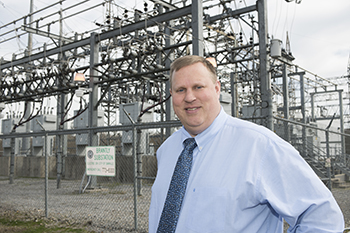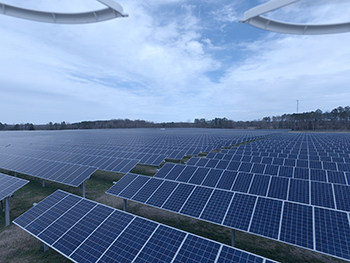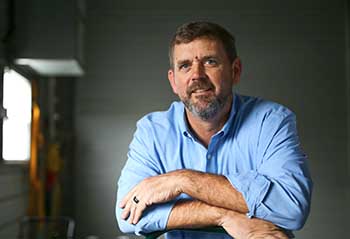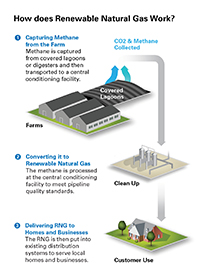Although Dominion Energy Inc. has pulled the plug on its $8 billion-plus Atlantic Coast Pipeline, natural gas remains a linchpin in the Richmond-based utility’s plan to shift from coal to renewable energy sources like wind and solar for electricity generation.
Dominion announced over the Fourth of July weekend that it was abandoning the pipeline and selling its gas transmission and storage assets to an affiliate of Berkshire Hathaway Inc., a transaction valued at $9.7 billion, including the assumption of $5.7 billion in existing debt.
The 600-mile conduit, which was to run from West Virginia through Virginia and into North Carolina, had faced protests and legal challenges from environmental and community groups since Dominion and Duke Energy joined forces on the venture in 2014. A major roadblock was removed in June when the U.S. Supreme Court cleared the way for the pipeline to cross underneath the Appalachian Trail, but legal and regulatory hurdles continued to threaten the project’s economic vitality.
Specifically, a Montana court decision regarding the Keystone pipeline overturned the U.S. Army Corps of Engineers’ authority to issue permits for water and wetland crossings. That decision is likely to lead to similar challenges related to pipeline permits, including ones that would have impacted the Atlantic Coast Pipeline.

“The project overcame a lot of challenges,” says Aaron Ruby, a Dominion media relations manager. “The Supreme Court’s decision was a vindication of the project and a decisive victory, but we reached the point where there were too many legal and regulatory uncertainties to continue.”
With the pipeline halted, Dominion is focusing on its regulated electric and natural gas utilities to serve customers and achieve its ambitious goal of reaching net-zero greenhouse gas emissions by 2050. Following the General Assembly’s passage of the sweeping Virginia Clean Economy Act overhauling how utilities generate power, the onus has been placed on Dominion to shift to renewable energy.
The state’s largest utility is committed to meeting that challenge with a multifaceted plan that includes a $7.8 billion offshore wind farm that would be the largest in North America, adding more solar farms, retiring coal-fired plants and exploring emerging new technologies such as battery storage and hydrogen carbon capture.
Keeping the lights on
During the next 15 years, Dominion plans to invest up to $55 billion across its 20-state footprint in emissions reduction technologies. Moody’s Investors Service notes that selling its pipeline assets will help Dominion reach its clean energy goals by immediately reducing the utility’s carbon and methane exposure.
Still, Dominion faces significant obstacles on its path to becoming carbon-free. Wind and solar generate energy only when the breeze is blowing and the sun is shining. Solar power reaches its peak midday when Dominion customers’ average energy usage is at one of its lowest points, while demand tops out during the morning and evening hours. As for batteries, energy storage technology is still in the early stages.

“We are all-in on renewable energy, particularly wind and solar, but our obligation is to meet our customers’ energy needs 24 hours a day, seven days a week, 365 days a year,” says Katharine Bond, Dominion’s vice president for public policy and state affairs in Virginia. “Wind and solar are fantastic resources, but you can’t store nearly enough of that energy for later use with current technology to meet all customer needs. We must have something on standby to ratchet up and down when the sun sets and the wind is not blowing.”
To fill the gap, natural gas, used in manufacturing, home heating and electric generation, is a critical tool in Dominion’s energy arsenal. “Natural gas is the only technology available to us today that we can turn up or down on a moment’s notice to respond to customers,” Bond notes.
Natural gas generates about 40% of electricity for Dominion’s Virginia customers, both residential and industrial. In Dominion’s long-term planning blueprint, natural gas is positioned to play a vital, low-emission role across the utility for decades to come.
The fossil fuel is the U.S.’s main source for electricity generation, despite pushback from environmentalists, elected officials and communities fighting the development of natural gas pipelines and power plants in the courts and in public opinion.
Natural gas also is an important part of Dominion’s broader strategy to become carbon-free.
“The common misconception is that natural gas and renewables are in competition and mutually exclusive,” says Ruby. “The opposite is actually the case. They work together to reduce greenhouse emissions from our electric fleet. Natural gas makes renewables work better and helps us bring more renewables on the grid.”
Ruby cites Dominion’s partnership with Smithfield Foods Inc. on a $500 million venture to convert methane from hog farms into renewable natural gas. “Without the ability to capture methane and turn it into natural gas for home heating, we would not be able to solve this environmental challenge.”
Additionally, Dominion is working with cruise lines and container vessels to convert their fleets from diesel and fuel oil to lower carbon liquefied natural gas. “The largest cargo ships generate [the same amount of] carbon emissions annually as millions and millions of cars,” Bond adds.
Dominion’s Integrated Resource Plan, filed with the State Corporation Commission in May, projects significant investments in solar, offshore wind and energy storage resources while deploying natural gas-fired generation to fill the gap. A road map for supplying energy needs over the next 15 years, the document is driven largely by the Virginia Clean Economy Act’s mandates.
Specifically, Dominion’s plan calls for more than 5,000 megawatts of offshore wind by 2035, including the 2,600-megawatt Coastal Virginia Offshore Wind project, which is slated to go in service off the coast of Virginia Beach in late 2026. Dominion, the nation’s fourth-largest utility operator of solar power facilities, also expects to develop approximately 16,000 megawatts of solar power over the next 15 years.
Additionally, Dominion plans to expand its energy storage capacity to approximately 2,700 megawatts, meeting ambitious targets established in the Virginia Clean Economy Act. That includes four battery storage pilot projects in Central Virginia slated to go online next year. It’s a promising technology, but Bond notes that average batteries currently can store and discharge energy for only four to six hours. “If we are looking at today’s technology and deploy that level of energy storage, we would still only serve about 650,000 to 675,000 customers for approximately four hours. If the battery runs out, we’re still obligated to keep our customers’ lights on.”
‘The sky is really the limit’
Clean energy advocates, along with the legislators who spearheaded the clean economy act, have criticized Dominion’s continued reliance on natural gas. In a joint statement, state Sen. Jennifer McClellan, D-Richmond, and Del. Richard C. “Rip” Sullivan Jr., D-Fairfax, said Dominion’s long-term plan “is tantamount to quitting the game before the first pitch is thrown.”
Dominion, however, contends that the plan complies with the Virginia Clean Economy Act while utilizing the least costly means to keep customers’ lights on. “We are obligated to maintain reliable service round the clock,” Bond says, adding that the utility is committed to deploying proven new technology as it becomes available and is cost effective for customers. “We can’t rely on hope, and we can’t hope that technological advances will get there.”
Meanwhile, with the pipeline canceled, Dominion acknowledges that energy needs will go unmet. Pipeline advocates say Hampton Roads and other communities across Virginia and eastern North Carolina experience chronic natural gas shortages and urgently need new infrastructure to support home heating, manufacturing and military and federal installations. In addition, demand for natural gas in Virginia and North Carolina is expected to almost double over the next two decades to support the transition to clean energy and the needs of growing populations and new industries.
“Over a dozen military bases and hundreds of manufacturing facilities all use natural gas,” says Bryan Stephens, president and CEO of the Hampton Roads Chamber of Commerce. “Right now, it’s coming from one pipeline operating at maximum capacity. If there is a surge, Dominion and other energy providers have to decide who gets natural gas and who doesn’t.”

Craig Quigley, executive director of the Hampton Roads Military and Federal Facilities Alliance, had hoped that the pipeline would ensure reliable, sufficient energy for local military installations. “If an installation doesn’t have that, its military value is lessened and perhaps becomes questioned,” he says. “The pipeline would have taken that off the table forever, but the military has mitigation strategies. We’ll make do.”
Pipeline opponents, however, contend the risks outweighed the benefits and would have locked Virginia into fossil fuel generation for years to come. “The road to economic growth when it comes to energy is not just one way and doesn’t just flow through the Atlantic Coast Pipeline,” says Cassady Craighill, communications director for Clean Virginia, an independent advocacy group. “The sky is really the limit in Virginia because we’ve had such dismal renewable energy opportunities for so long.”

More pipes in the pipeline
William Limpert, a retired environmental regulator, met the pipeline’s termination with a mixture of elation and relief. Limpert, who previously owned property along the pipeline’s route through Bath County, was concerned about the potential for explosions, landslides and water pollution.
“If Dominion hadn’t planned for the Atlantic Coast Pipeline and invested in renewable energy six years ago, they would be way ahead of where they are in preventing a climate catastrophe, which is still looming,” he contends, although he adds that the utility can still meet its clean energy goals. “If they put their mind to it, they could make great strides in providing renewable energy.”
Limpert is also “dead set against” the Mountain Valley Pipeline. A joint venture between partners including subsidiaries of Consolidated Edison Inc. and EQT Corp., the $5.2 billion, 303-mile pipeline is being constructed from West Virginia through Southwest Virginia to Central North Carolina. “These pipelines are not a bridge to renewable energy,” he says. “In terms of greenhouse gas emissions, natural gas is just as bad as coal. All of us will suffer if these gas pipelines are built. It will lock us into three or four decades of continued fossil fuel use.”

Also dogged by legal challenges, the Mountain Valley Pipeline is nonetheless more than 90% complete and expected to go into service in 2021. A day after the Atlantic Coast Pipeline was shelved, the U.S. Supreme Court removed a key barrier toward the Mountain Valley Pipeline’s progress when it issued a stay of a Montana judge’s ruling banning a fast-track permitting process that allows pipelines to cross bodies of water. Mountain Valley needed such a permit in order to complete construction.
Virginia Beach-based Virginia Natural Gas also has encountered opposition in its quest to connect its pipeline system to an interstate pipeline in Northern Virginia. Opponents contend the $346 million Header Improvement Project would accelerate climate change, impact wetlands, impede landowners’ rights and burden ratepayers, as well as expose communities of color and low-income people to noise and air pollution.
In June, the SCC ruled that approval for the pipeline hinges on Virginia Natural Gas placing a strict cap on costs billed to its residential and business customers. The SCC made the determination in part because the project’s main driver, C4GT, a power generation facility in Charles City County, would pay the majority of its costs. “It is imperative that VNG’s other customers not be left ‘holding the bag’ for the costs of the project should C4GT cease operating before those costs have been fully recovered,” the SCC said in a statement.
Virginia Natural Gas has until Dec. 31 to fulfill the requirements issued in the SCC’s ruling.
The Header Improvement Project includes 24 miles of pipelines and three new or expanded gas compressor stations in Prince William County, Caroline County and Chesapeake. VNG says the project will enhance operational capacity to ensure that the utility, along with C4GT, Columbia Gas of Virginia and Dominion subsidiary Power Services Energy, have access to reliable natural gas.
Reliability — coupled with safety — is key, adds Dominion’s Bond. “We’ll be looking at every opportunity we can to help serve customer needs. Our customers expect their lights to turn on when they flip a switch. We can’t compromise on that.”












 Telemedicine has also alleviated the scarcity of psychiatrists in rural areas. “Telemedicine extends psychiatrists’ reach,” says Steve Morgan, chief medical information officer for Roanoke-based Carilion Clinic. “A rural patient’s primary care doctor initiates a psychiatric consult over telemedicine. It’s a learning opportunity for the primary care doctor in treating mental health.”
Telemedicine has also alleviated the scarcity of psychiatrists in rural areas. “Telemedicine extends psychiatrists’ reach,” says Steve Morgan, chief medical information officer for Roanoke-based Carilion Clinic. “A rural patient’s primary care doctor initiates a psychiatric consult over telemedicine. It’s a learning opportunity for the primary care doctor in treating mental health.”